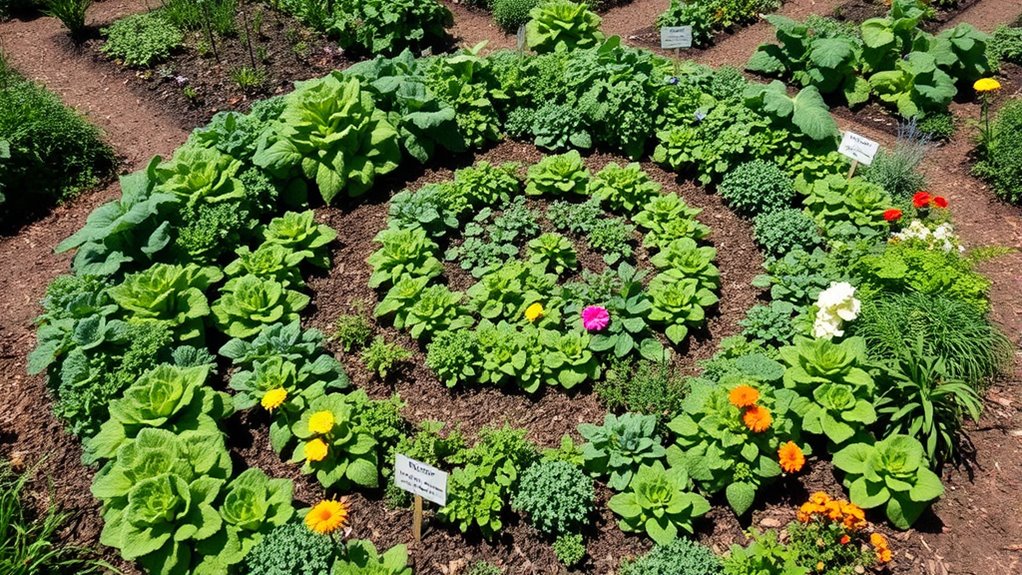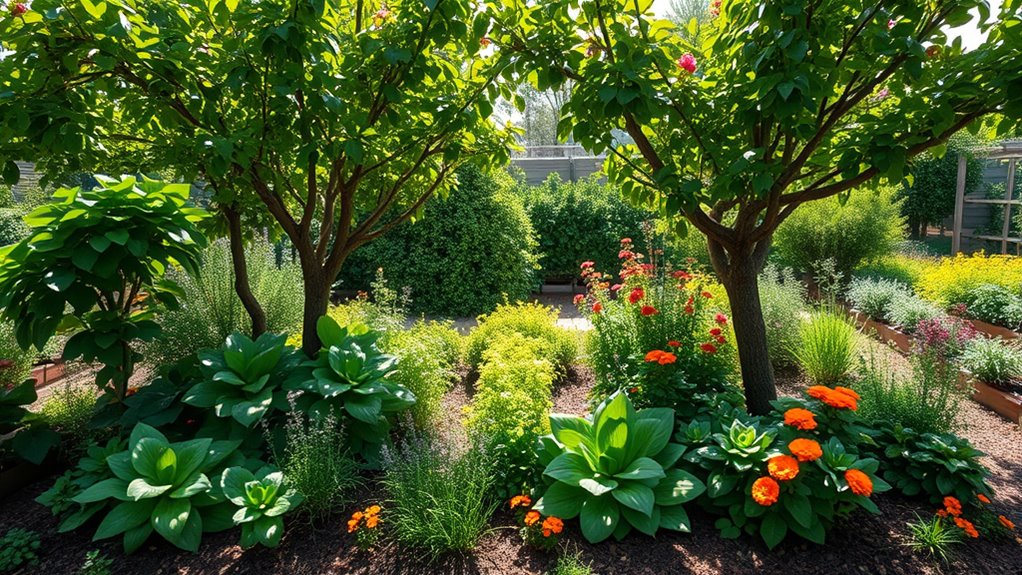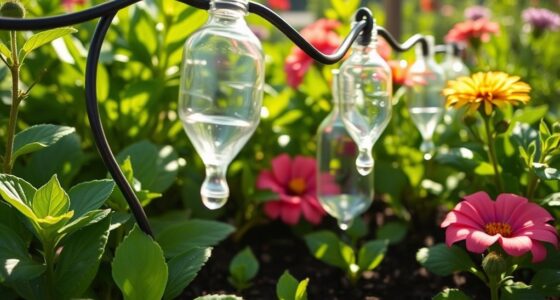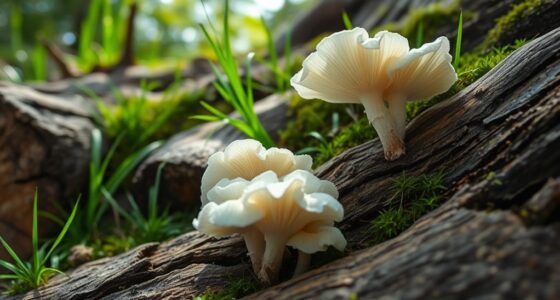Permaculture guilds design planting layouts that naturally regulate themselves by encouraging beneficial plant relationships. You place main crops, like fruit trees, surrounded by companions such as nitrogen fixers, pollinators, and pest repellents, creating a resilient ecosystem. Strategic placement maximizes interactions, reduces pests, and improves soil health. Incorporating biodiversity with native plants and diverse species guarantees sustainability. To discover how to build these self-policing systems, you’ll find valuable tips and examples if you keep exploring.
Key Takeaways
- Strategic plant placement enhances natural pest control and beneficial interactions, reducing the need for manual intervention.
- Incorporate diverse plant species to create a resilient ecosystem that naturally suppresses pests and diseases.
- Use companion planting principles to ensure mutual support and prevent competitive relationships among guild members.
- Arrange plants vertically and seasonally to promote continuous productivity and ecosystem stability.
- Regular observation and adaptive management maintain the self-regulating balance of the guild.
Understanding the Core Principles of Permaculture Guilds

Understanding the core principles of permaculture guilds begins with recognizing their focus on mutual benefits among diverse plants and organisms. You create a system where each plant has a specific role, working together to enhance productivity and resilience. The primary plant, such as a valuable crop or tree, serves as the centerpiece. Surrounding it, nitrogen fixers improve soil fertility, while dynamic accumulators cycle nutrients to the surface. Pollinator attractors boost biodiversity and help with crop pollination, and pest-repellent plants naturally reduce pest issues. These components work as a cohesive unit, recycling nutrients, conserving water, and supporting wildlife. This interconnectedness by grouping plants based on their functions and niches, you design a self-regulating, sustainable ecosystem that mimics natural processes and reduces maintenance needs. Incorporating empathy into your design process can also help you better understand the needs of various organisms within the system.
Strategies for Designing Self-Regulating Planting Layouts

Designing self-regulating planting layouts requires strategic placement of plants to maximize natural interactions and resource use. You should plan schedules that align with seasonal growth patterns, ensuring continuous productivity and ground cover year-round. You should also consider plant compatibility to promote beneficial relationships and prevent resource competition. Incorporate plants suited to different seasons to sustain ecosystem activity, with early bloomers supporting beneficial insects when other plants aren’t flowering. Use perennials alongside annuals to provide stability and fill temporal niches, reducing bare patches and weed intrusion. Arrange plants vertically from tall trees to ground cover, mimicking natural forest layers, and consider mature canopy sizes to prevent shading. Position nitrogen fixers and dynamic accumulators near heavy feeders for optimal nutrient cycling. Aligning plant choices with local climate conditions is essential for success. This strategic layering and timing create resilient, self-policing systems that require minimal intervention over time.
Incorporating Biodiversity for Ecosystem Resilience

Incorporating biodiversity into your guilds substantially boosts ecosystem resilience by creating a more adaptable and self-sustaining system. Native plants support diverse herbivorous arthropods and facilitate egg-laying, enriching food webs, while non-native plants often lack these connections. A variety of plant species reduces disease and pest problems by disrupting pest cycles and attracts beneficial insects and pollinators, boosting crop productivity. Higher bird diversity results from a range of habitats and food sources, further controlling pests naturally. Diverse ground covers suppress weeds and improve soil health. Functional diversity, with plants fulfilling roles like nitrogen fixation or pest repellence, enhances resource use. Maintaining floral diversity at multiple scales sustains pollinator populations, ensuring resilient, productive ecosystems that require fewer chemical inputs. Supporting beneficial insect populations also contributes to natural pest control and pollination, reinforcing the overall health of the food forest. Additionally, incorporating biodiversity into your planting layouts can promote ecological balance and long-term sustainability.
Practical Steps to Establish and Maintain Guilds

To successfully establish and maintain a permaculture guild, start by carefully planning and designing your site. Assess the landscape’s ecology and climate to select suitable plants that thrive there. Begin with a small area, like a 20×20-foot square, to keep it manageable. Choose a central plant, such as a fruit tree, that will serve as the guild’s focus. Determine each plant’s function—whether fixing nitrogen, deterring pests, attracting beneficial insects, or improving soil health—and plan their placement accordingly. Prepare the soil by testing nutrients, adding organic matter, and mulching to retain moisture. Plant the central tree first, then arrange other plants around it, layering for diversity. Regular observation, pruning, and soil management will keep your guild healthy and productive over time. Understanding permaculture principles and plant interactions can greatly enhance the success of your guild, ensuring a resilient and self-sustaining system. Incorporating water management techniques inspired by water parks can help optimize moisture retention and drainage in your design.
Examples of Successful Permaculture Guild Implementations

Many successful permaculture guilds demonstrate how thoughtfully combining plants creates resilient, self-sustaining ecosystems. For example, the Three Sisters guild pairs corn, beans, and squash: corn provides a pole for beans, beans fix nitrogen, and squash suppresses weeds while retaining moisture. Fruit tree guilds often center around a fruit tree, supported by plants like comfrey, chives, and daffodils that repel pests, attract pollinators, and improve soil fertility. The Apple Tree Guild includes disease-resistant apples, garlic chives, bee balm, and comfrey to enhance growth and reduce pests. Tomato guilds feature tomatoes with borage, carrots, tulsi, and beans, maximizing space and nutrient cycling. Globally, farms like Ferme MiKu Valley in Canada and Findhorn Ecovillage in the UK incorporate guild principles, boosting productivity and resilience. Understanding plant symbiosis helps optimize the relationships among guild components, leading to more effective and sustainable ecosystems.
Frequently Asked Questions
How Do Permaculture Guilds Adapt to Changing Climate Conditions?
You adapt to changing climate conditions by designing your guilds based on thorough site assessments, including climate data and microclimates. Incorporate diverse, resilient plants with multiple functions, like drought tolerance and pest resistance. Use water harvesting and soil conservation techniques to manage resource fluctuations. Continuously monitor and adjust your system as weather patterns shift, ensuring your guild remains productive, resilient, and self-sustaining in the face of climate change.
What Are Common Mistakes to Avoid When Designing a Guild?
When designing a guild, you should avoid overplanting or underplanting, as it causes resource issues. Don’t ignore the specific needs and preferences of your plants, which can lead to poor health. Make certain you prepare the site properly and consider long-term maintenance. Avoid neglecting pest management, plant diversity, and future growth, as these prevent guild efficiency. Proper planning ensures your guild remains sustainable and resilient over time.
How Long Does It Typically Take for a Guild to Become Self-Sustaining?
Think of your guild as a young sapling slowly growing into a mighty oak. It usually takes about 2 to 5 years for a guild to reach self-sustainability, where it starts to thrive independently. During this period, the plants develop intricate relationships, like a well-rehearsed orchestra. Patience and ongoing care help it mature, ensuring it becomes resilient, balanced, and capable of supporting itself with minimal external input over time.
Can Permaculture Guilds Be Integrated Into Existing Gardens or Landscapes?
Yes, you can integrate permaculture guilds into your existing garden. Start with a site analysis to understand your soil, climate, and light. Introduce diverse plants gradually, choosing compatible species that support each other. Use layering to maximize space, and consider existing cover crops to minimize disturbance. With careful planning and patience, your garden will become more resilient, productive, and self-sustaining over time.
What Maintenance Is Required to Keep a Guild Functioning Optimally?
To keep your guild thriving, stay steady with specific, seasonal steps. Regularly prune to promote healthy growth, harvest promptly to encourage productivity, and mulch meticulously to maintain moisture and suppress weeds. Monitor for pests and diseases, and adapt plantings as needed. Maintain water wisely, and manage soil with natural nutrients. Consistent care guarantees your garden grows gracefully, gaining resilience and reaching its full potential over time.
Conclusion
By designing your permaculture guilds thoughtfully, you create resilient, self-regulating ecosystems that need less intervention. Did you know that diverse plantings can increase crop yields by up to 30%? This statistic highlights the power of biodiversity in boosting productivity and ecosystem health. When you implement these principles, you’re not just planting; you’re building sustainable systems that police themselves, ensuring long-term success with minimal effort. Start small, and watch your guilds thrive over time.
I’m Theodore, and I love tiny houses. In fact, I’m the author of Tiny House 43, a book about tiny houses that are also tree houses. I think they’re magical places where imaginations can run wild and adventures are just waiting to happen.
While tree houses are often associated with childhood, they can be the perfect adult retreat. They offer a cozy space to relax and unwind, surrounded by nature. And since they’re typically built on stilts or raised platforms, they offer stunning views that traditional homes simply can’t match.
If you’re looking for a unique and romantic getaway, a tree house tiny house might just be the perfect option.










